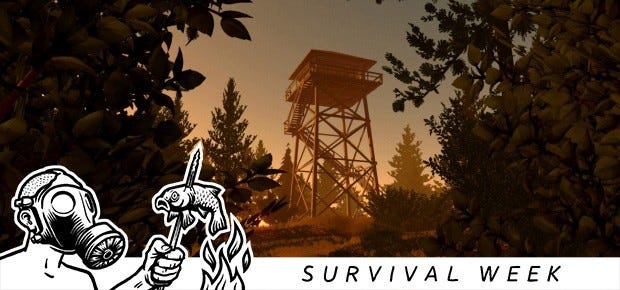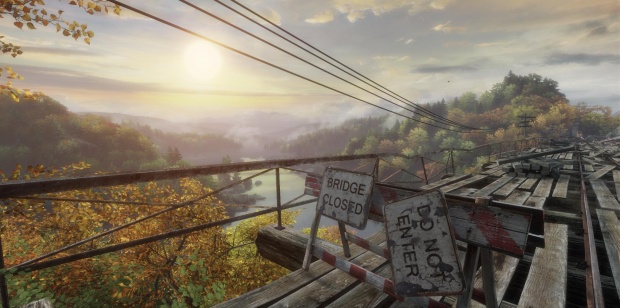Field Notes: How Devs Recreate Wilderness In Games
A field guide, if you will
Most survival games are set in the great outdoors, and while The Vanishing of Ethan Carter and Firewatch aren't survival games, both have taken interesting steps to present natural wilderness. We asked Mitch Bowman to find out more.
The outward appearance of everything on Earth that wasn’t made by humans is one big accident. It’s the result of a bewilderingly complicated system of interactions between organisms that couldn’t care less how pretty their surroundings are, and the end result isa chaotic mess.
As you might imagine, that makes it pretty tough for environment artists to recreate the corners of the planet that humans haven’t messed with. We understand cities - we know what they’re for, we know why they were designed the way they were, and we probably even have some idea how they were built. Not so with the great outdoors, and that presents an interesting challenge to those attempting to emulate wildernesses in video games.
Recently, there’s been some admirable attempts at doing so. The Vanishing of Ethan Carter has been heavily praised for its scenery, and has produced some frankly astonishing-looking screenshots. The eight person development team at The Astronauts knew from the very beginning of Ethan Carter’s development that they wanted to have a heavy focus on the game’s environments, and they went to great lengths to build a convincing wilderness for the player to get lost in.
“We really really wanted to start off with environment and not with game and level design,” says Andrew Poznanski, the lead artist on Ethan Carter.
His history, along with most of his compatriots at The Astronauts, is at People Can Fly, working on a variety of shooters like Painkiller, Bulletstorm, and assisting Epic with the Gears of War games. “For those games, art was just a dress-up for those artificial level shells that were all about meeting criteria. There were those game rules, and then we were trying to make these playing fields look like real worlds. That never worked out as well as we wanted it to work out,” Andrew says.
“So this time around, because there wasn’t a cover system and crouch height and jump height and all of that stuff that confines artists, we wanted to go absolutely crazy with realism of this place.”
It took more than simple prioritization to make Ethan Carter’s environments so impressive, however. To be able to create a truly believable wilderness, The Astronauts had to go on an adventure to the Karkonosze mountain range in Southern Poland.
“Once we all had our idea of where we wanted this game to happen, we just packed our things, grabbed a lot of digital cameras, and went there,” Andrew explains. “That was more than two years ago when we took our first trip over there and started putting things together in our heads. After a few days of hiking there, we went back and started creating some first mockups of the world.”
More than just gathering reference photos, The Astronauts were gathering what would become their actual game assets. They returned to the mountains several times to gather more images, and using a process called “photogrammetry” (which they’ve talked about in detail on their developer blog), Andrew and friends converted the photos from their trip directly into 3D models and textures. The result is a world that Andrew believes to be more convincing than any artist could ever make from scratch.
“There’s so many things that even the best skilled artist, when trying to mimic reality, will just fail at,” he says. “They’ll just not see them, or not think they’re relevant; there will be all these nuances that will be lost when creating [art that’s supposed] to mimic reality. Erosion, how moss will sit on a rock on one side but not the other, how it will sit in the cracks but not anywhere else...there’s a lot of things that reality will get right but people rarely do. So for creating believable wilderness, I think that this is the number one thing, to not try to figure out how reality works, but to just plain use what’s real.”
Meanwhile, other developers have taken a different approach in their attempts to create convincing wildernesses.
For their upcoming debut game Firewatch, San Francisco-based developers Campo Santo have dispensed with the notion of photorealism entirely. “We were never operating under the idea that we would be able to have anything resembling the uniqueness of actual nature,” says Jake Rodkin, Campo Santo’s creative director. “Part of the reason that the game’s style is what it is, is because we knew that if we did try to get the shapes and colours and layering that you feel when you’re outside, but then pushed the actual level of detail back into a little bit more of a stylized sort of blocky feeling, we hopefully can get something that’s evocative of it in an impressionistic way, even if every single needle on every single tree isn’t unique.”
Set near the forest surrounding a fire lookout tower in Wyoming’s Yellowstone National Park, there’s all sorts of natural vistas to be portrayed in Firewatch, and even the game’s first trailer does an amazing job of evoking the feeling of the American West.
Like The Astronauts, Campo Santo’s endeavour required some real-world research as well. Beyond the endless hours spent poring over Google image search results, the team also went on a camping trip to gather field notes for their game environments.
“A number of people on our team didn’t grow up in America, or didn’t grow up in the American West, and just hadn’t really gone to see the outdoors that we were depicting in the game at all, let alone the specifics of Wyoming,” Jake says. “So we ended up just going to Yosemite [National Park, in California], because it was a place that we could drive the team to from San Francisco in half a day. We could get there, set up a camp, and then immediately just get outside.
“The reason for it was to just be able to get out in the middle of nowhere, and get out away from cities. It’s not 100% in line with Wyoming, because Wyoming has some of that more sort of sandstone-y brown-ness to it, with big sagebrush and stuff… but just going out with the team and hiking and being out basically away from all other humans with nothing but the outdoors was fantastic.”
The team also managed to find a fire lookout tower in Yosemite that was very similar to the one that they’re representing in the game, which Jake says proved invaluable. “We hiked up to it, went up the stairs, got out and just looked out and could see just...infinite mountains and valleys stretching out. It was almost a cliche moment but Olly [Moss, an artist at Campo Santo] who was there with us was like ‘Oh, I get it now. Trip worth it.’”
Despite the differences in how they’re approaching the representation of wilderness in their games, both Jake and Andrew expressed a similar desire as to what they wanted their game environments to accomplish.
“The most wonderful comments, and the ones that I took closest to heart, are the ones where people just felt the world. They didn’t speak about how amazing the natural texturing is, or how detailed the environments we have are, or how perfect those rocks look,” Andrew says. “If there are no things that take you away from the reality of the game, this is the biggest win, and this is the biggest compliment that anyone can give me. When people do not even talk about graphics, they just tell about how they were immersed in the game, how they could lose themselves in this world, and how deeply they felt some of the events that took place in our game. this is what tells me that our environments were really working for players.”
Jake, expressing a similar sentiment, says, “I think what we hope is that if you step back and look at what’s coming out of your screen as a screenshot or as a composition, as a piece of created work, it will look stylized and specific and designed. But all of the pieces of the game aesthetically, when you’re inside it, when you’re just walking around as a character in the world, you don’t notice and it just gives you the same sort of emotional reaction as you would get from nature.”
You can read more Survival Week articles over here.











